Web Japan > Trends in Japan > Fashion&Design > Bonsai
Bonsai - Japanese “Art Form” that has been reproducing Nature for more than 800 Years.
Japan is 70% forest. Next to Finland, in terms of developed countries, it has the second highest ratio of forests in the world. Japanese people have lived surrounded by woodland and their very existence is intertwined with that of the trees. The people of Japan have incorporated trees into their lives using Bonsai; a hobby that can even be called an Art, where magnificent natural landscapes are created in small plant pots.
It is said that ornamental plants and trees were first planted in containers around 800 years ago, and today they are even popular overseas. There is even a World Bonsai Convention held once every four years, with the 8th convention due to be hosted in Saitama City, Japan in 2017. Bonsai enthusiasts from across the globe gather at the conventions to improve techniques and cement bonds of friendship. It seems that the Bonsai craze is set to further grow, as even smaller mini-Bonsai gain popularity amongst young people.
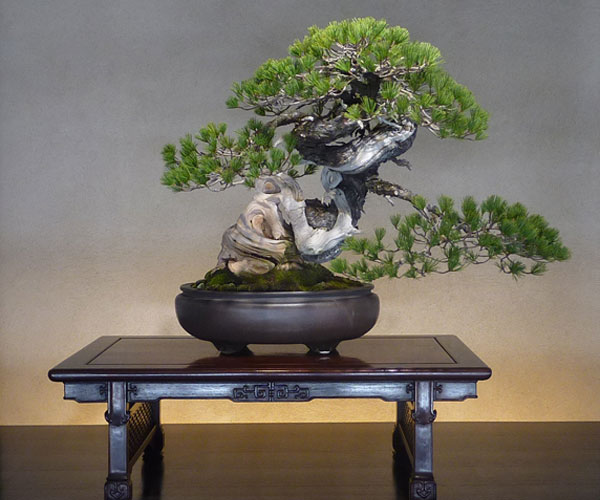
Japanese Five Needle Pine named Uzushio. © The Omiya Bonsai Art Museum, Saitama
Shape into your Desire Form
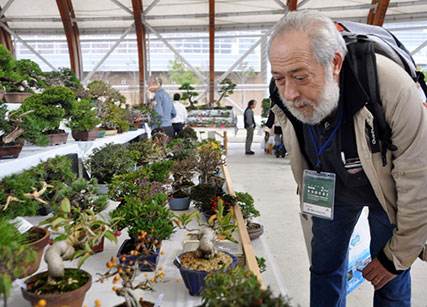
An overseas visitor inspecting Bonsai.© KyodoNews
In all countries, people enjoy planting shrubs in pots. Looking at a potted plant placed in the corner of a room allows a sense of peace and healing. Potted plants bring a breath of fresh air to our daily lives, whether it is in the company office or in the home.
However, although such simple pot plants and Bonsai may seem similar, they are quite different.
Bonsai are not just a matter of planting some shrubs in a pot; instead they reproduce a natural scene in a pot. This means that trees that grow several meters high in nature, must be cultivated to match the size of the pot, and may range in height from a few dozen centimeters to around 1 meter.
However, trees are living things and so even though you may think you are training them into your desired shape, they can shoot buds or grow branches in unexpected places. As a result, you need to observe a tree’s form and almost "talk" to it; nurturing it over several years by pruning it and factoring in various needs such as sunlight, water and fertilizer etc. By so doing, the tree will finally take on the form you had envisaged. That is the real charm of Bonsai.
The Japanese Sense of Beauty
There are various different species of Bonsai. Among others, we use evergreen such as pine or traditional oak; species such as maple and Japanese elm whose leaves change with the four seasons; and plum or satsuki azalea whose flowers can be enjoyed. However, for many Japanese people "Bonsai" is likely to bring the pine tree to mind.
In addition, there are various styles in which trees can be potted and cultivated. The most basic style is that where the trunk grows straight up, getting gradually thinner from the root to the tips; a style called Chokkan (literally “straight trunk”). Then there is Shakan (literally “tilted trunk”), where the trunk is tilted to left or the right, as when a wind-swept tree grows at an angle in nature. Stretching the trunk by twisting it and bending it backwards and forwards, left and right, is called Moyogi (literally “patterned tree”).
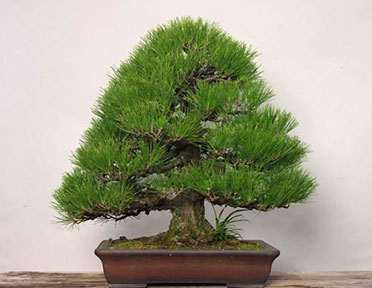
|
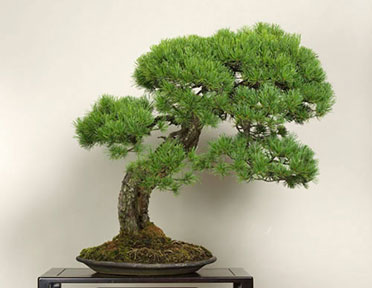
|
| “Black Pine” – named Seiran (literally “blue storm”) – a typical example of Chokkan. © The Omiya Bonsai Art Museum, Saitama | “Japanese Five Needle Pine” – beautiful with its harmony of tilted trunk and branches. © The Omiya Bonsai Art Museum, Saitama |
Yet this does not mean that there is a set definition or determination for how Bonsai "should be cultivated." In nature no two trees are the same; branches bend and trunks tilt as they are exposed to the wind and the rain, and roots also sprout up. Essentially, the enjoyment of recreating such elements and reproducing nature translates into the Japanese sense of beauty called Wabi Sabi (the sense of beauty found in quiet, subdued refinement.)
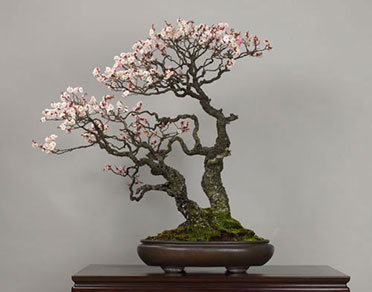
|
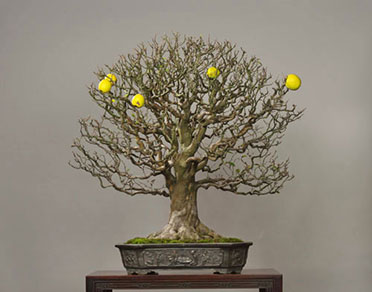
|
| The Japanese Apricot comes into blossom with beautiful flowers in early spring. © The Omiya Bonsai Art Museum, Saitama | The striking quince, with its tips flickering as if aflame. © The Omiya Bonsai Art Museum,Saitama |
The World’s First Bonsai Museum of Art
The Omiya Bonsai Art Museum is located in Saitama City, Saitama Prefecture not far from Tokyo and is a centre of interest for Bonsai enthusiasts. It opened in March 2010 as the world's first public art museum for Bonsai. It exhibits not only Bonsai masterpieces, but also the trays used to pot Bonsai and ornamental stones etc. The museum also provides vocal guides in English, Chinese and Korean, allowing people from overseas to not only enjoy looking at Bonsai, but also to learn about aspects such as its history.
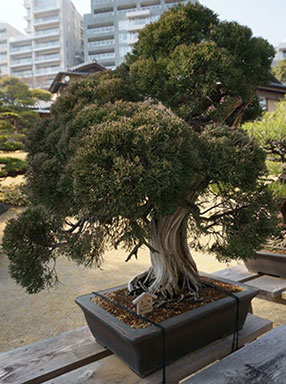
A traditional oak around 520 years old, displayed along the Bonsai Road.
The gardens of Happo-En, a wedding venue in Tokyo's Minato district, are also of interest to Bonsai lovers. Here you can find the so-called "Bonsai Road", a path that displays Bonsai trees over 100 years old along its length.
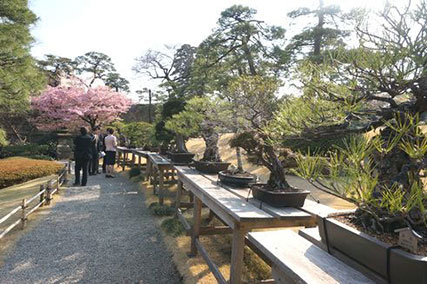
Bonsai Road in Happo-En.
These Bonsai all have foliage carefully tended by hand and nurtured only by experts. Among them are a traditional oak and an Ezo pine that are 520 years old; standing around 1 meter tall they seem like "big trees" and the sight of them takes your breath away. Anyone can appreciate the Bonsai, such as those using the café, and in recent times foreign travelers have also been visiting, as well as Japanese Bonsai fans.
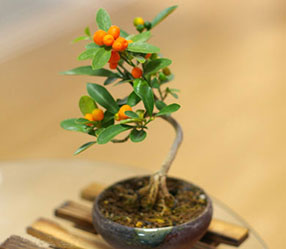
A mini-Bonsai kumquat with cute orange fruit. (Photo courtesy of Garden x Garden)
Mini-Bonsai – Popular with Youngsters
On the one hand, it is true that Bonsai have a reputation for being “difficult to cultivate” and “a hobby for the rich and the older generation.”
However, recently there has been an increase in the number of youngsters with an interest in miniature Bonsai that are around 10-20 centimeters in height. Trees of this height come under the category of “small Bonsai” and in recent years have also become known as “mini-Bonsai.”
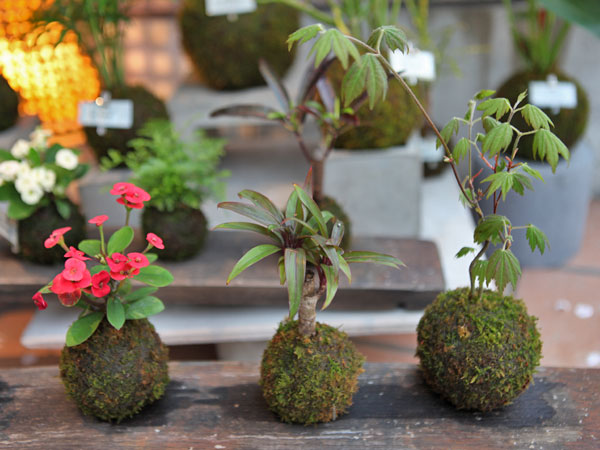
The "Moss Ball" is a technique that creates Bonsai by wrapping the plant's roots in a ball of clay-rich soil and moss, bound together with thin thread. As well as being used for typical Japanese Bonsai with foliage that turns into autumnal hues (right-hand side of photograph), moss balls can also be enjoyed with various other types of ornamental plant. (Courtesy of GreenScape)
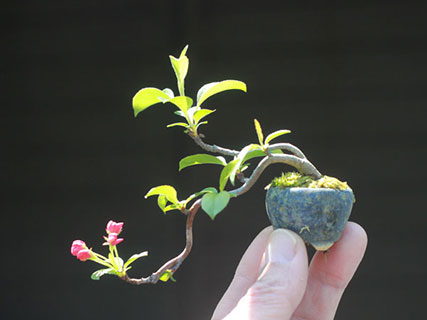
"Super Mini Bonsai"; Mini Bonsai made even smaller. Full-sized Bonsai take more than 20 years to reach a height of 20 cm, whereas a Super Mini Bonsai can reach its full height of around 3 cm in just 3 years. This photograph shows a Toringo Crab Apple. (Courtesy of Teruki Iwai)
As with regular Bonsai, there are various kinds of mini-Bonsai in terms of fruit and foliage; those with leaves that change color in the autumn; or those that produce fresh green leaves etc. Many people place them on tables, or on window sills, to enjoy them. Mini-Bonsai is affordable, priced at a few thousand yen, and these days can easily be purchased by mail order from the Internet. As a result they are becoming popular amongst students, female office workers, and salaried workers etc.
(April 2014)
